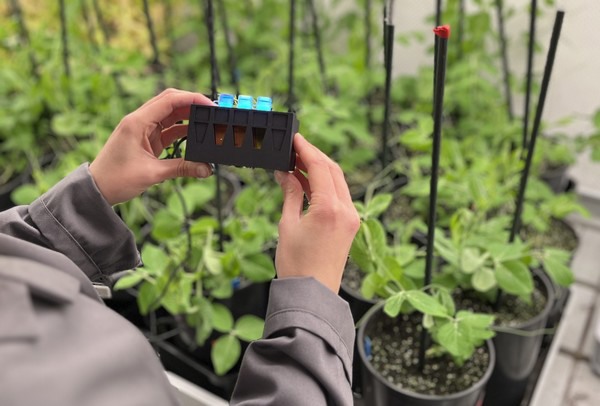Since last summer, a test kit has been on the market that allows growers to test plants for the presence of Tomato brown rugose fruit virus (ToBRFV) in a pre-symptomatic phase quickly, easily, and anywhere. However, the virus does not just turn up in plants. Hence, producer Spark Radar has been working on expanding its testing capabilities. Besides the existing tests for ToBRFV, a test for cucumber mosaic virus (CGMMV) has also been added to the range.
Building on the ToBRFV test for leaf material, there is now also a test to check seeds, water, and surfaces for the presence of the virus. Rogier van der Voort, co-founder of the company, announced those tests late last year.
The hardware provided by Spark Radar that growers use to carry out the test is the same for each test variant. This means that growers do not have to make any additional investment to want to use a different testing method, such as water or surface. The initial operations for the water test are different (collecting and filtering water is different from pipetting juices from leaf material), but otherwise, the principle works the same.

Quick
The standard hardware to perform the test with is also the same for the new tests. Spark Radar developed a magnetic rack and a detection rack. By using the magnetic rack, the tester pulls the virus out of the sample, so to speak. "It partly ensures the high sensitivity of our test. Even in the presence of a low virus load, the test will detect the virus."
An important caveat to the use of the rapid PCR test, however, is that the result of the test does not give a definitive answer as to whether the virus found is dead or alive. "No test can do that so far. For this, you really need to do a bioassay," Rogier knows. The fact is that growers want to test quickly, and Spark Radar's test, in particular, makes this possible even faster than testing through a laboratory.
Virus localization and containment
Growers' demand for the tests is high. They use the tests to check whether the virus is present after cleaning the greenhouse after cultivation with water samples, for example, but above all frequently to keep control and limit damage, is the experience of Rogier and his partner Bas Rutjens. "As long as the virus is still plentiful, there is a need for a solution that can detect the virus at a pre-symptomatic stage."
Growers are trying to learn to work with the virus as best they can. "In doing so, they use our tests to locate the virus and use that knowledge to contain the virus as best they can."
Testing seeds for ToBRFV
Also new is a test for seeds. Following a specific request from a breeder in Italy, Spark Radar also developed a test for seeds in recent months. In it, up to 500 seeds can be tested simultaneously. "The procedure to test seeds is slightly different from leaf material. This is because to detect the presence of the virus in seeds, extra time is needed to remove the virus from the seeds. The material needs to sit for 12 hours in the buffer extraction bag we supply before the test can be carried out," Rogier points out. "That way, one can then use the existing hardware to pull the virus out of the sample, so to speak."
International
The demand for ToBRFV testing is certainly not just Dutch, although based on official figures, that is where the number of infections seems to be highest. The Netherlands has 50, according to the most recent official NVWA figures. However, the virus is also present in other countries and spread internationally continues.
At Spark Rader, in addition to in the Netherlands, they have now supplied tests to the necessary well-known tomato growing areas in Europe, such as Belgium, France, and Italy, as well as in the United States and Canada. "In North America, the need for a functioning pre-symptomatic ToBRFV test is very high. Even from the corner of vertical farming, we are getting questions about it. We are currently conducting a lot of demos, where we send the first test kit with the necessary hardware and then go through the test online afterwards so that growers can use the test in the best possible way."
Rogier says early detection of ToBRFV is necessary to avoid major crop losses. "Outsourcing testing often takes too long and is costly. Embedding periodic testing in the protocol prevents major losses. Besides growers adapting their protocol and starting to test more with proper pre-symptomatic testing, we see that they are also testing more at the gate." For example, growers are testing incoming plant material before planting. "Even on young plants about 30 centimeters high, we have seen that the test can show that the virus is present."
Cucumber fur virus
Due to virus pressure, the necessary tomato growers have also started growing cucumbers. Here, too, they encounter viruses. One well-known virus is the cucumber mosaic virus (CGMMV). As announced late last year, Spark Radar now also has a test available for this. "Still only a leaf test at the moment, though, because we want to see how much demand there is for this test in the coming months. If that demand is there, we'll pick up with more test options just as we did with ToBRFV."
Needle in a haystack
"We are now investing in these two viruses before we think about adding new viruses and pathogens to our test range. Our aim now is to help growers find a needle in a haystack. With the additional testing options for ToBRFV, we have made strides in this. For example, growers take a water sample first and can then zoom in with a leaf sample. That way, they know better where to look for the virus."
For more information:
Rogier van der Voort 
Spark Radar
Padualaan 8
3584 CH Utrecht
rogier@sparkgenetics.com
info@sparkradar.bio
www.sparkradar.bio
